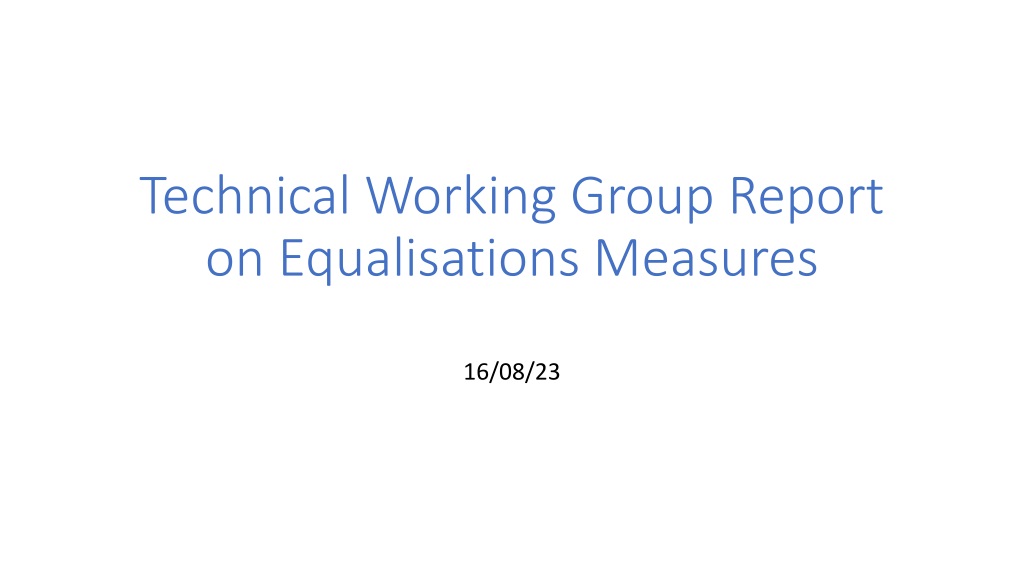

0 likes | 13 Views
The report discusses the impact of no equalisation measure and a higher base royalty on capturing resource rent effectively. It explores the implications of base royalty rates on contractors with and without corporate income tax (CIT), highlighting the need for fair rates to achieve an effective tax rate. The proposed hybrid additional royalty and top-up profit share system aim to address tax avoidance, subsidy issues, and promote fairness between contractors and authorities.

E N D
Technical Working Group Report on Equalisations Measures 16/08/23
Would no equalisation measure and a higher base royalty effectively capture resource rent? •Impact of No Equalisation Measure • Base royalty rates chosen to give “fair” ETR = 42.6%, for contractors paying 25% CIT • These rates result in ETR = 24.9% for contractors paying no CIT • Base royalty rates need to double for contractors paying no CIT to reach “fair” ETR level • However, these royalty rates result in unfair high ETR = 55.1% for contractors paying 25% CIT • Royalty rates and average ETR are outside fair ranges identified in previous studies of land- based mining for contractors paying 25% CIT
Results in absence of an equalisation measure? Rates set to achieve ETR = 42.6% assuming 25% CIT Rates set to achieve ETR = 42.6% assuming 0% CIT Contractors paying 25% CIT Contractors paying 0% CIT Contractors paying 25% CIT Contractors paying 0% CIT 1stPeriod Royalty Rate 2.5% 2.5% 2.5% 2.5% 2ndPeriod Royalty Rates 4.5% -9.5% 4.5% -9.5% 9% - 19% 9% - 19% ETR 42.5% 24.8% 55.1% 42.6% Lifetime Royalty Revenue (undiscounted) $3,682 million $3,682 million $7,148 million $7,148 million Contractor IRR 15.9% 17.4% 14.9% 16.4% Options: 1. 2. 3. Charge royalty rates far above normal experienced in land-based mining Forgo significant resource rents that could be obtained from collectors paying no CIT Implement an equalisation system
Preferred Option: Hybrid Additional Royalty and Top Up Profit Share (1) What is it: “Contractor will pay the additional royalty provided for in Regulation [R] unless an Independent Auditor confirms: a.) the Contractor does not have any Exemptions from sponsoring corporate income tax or any other sponsoring state tax; b.) the Contractor does not receive any Subsidy from the Sponsoring State or any other state; and c.) the Contractors has met the requirements of the Top-Up Profit Share provided for under Regulation [R]. “
Preferred Option: Hybrid Additional Royalty and Top Up Profit Share (2) Explanation of Top Up Profit Share Component • provides that a Contractor pays an additional amount to the ISA if the taxes that it and all its related entities involved in mining operations pay to all states are less than 25% of the profits from mining operations. • the amount of the equalization payment would be the difference between the equivalent of 25% of profits and the amount of taxes paid. • this equalization measure would use OECD GloBe definitions of profits and taxes, which would simplify tax administration and audit, and allow the ISA to lean on a growing body of international tax audit expertise in this area.
Preferred Option 1: Hybrid Additional Royalty and Top Up Profit Share Why did we choose this option: • Demotivates tax avoidance and subsidies in sponsoring state, • Provides minimum revenue for sponsoring state (amount payable under CIT and other taxes), which was not the case for initial top up profit share, • Better at equalisations and fairer to contractor and authority than additional royalty only • Better at demotivating profit shifting between jurisdictions than additional profit share • Builds on existing definitions of covered taxes, profits and costs under OECD GloBe Weaknesses: • There is still some uncertainty around the implementation of OECD Globe, subsidies in non- sponsoring state and unknown potential work arounds from GloBe; and • Defining and implementing the concept of the mining perimeter. • There continues to be a risk of transfer mispricing.
Possible Option 2 Additional Profit Share Why did we choose this option: • better at equalisation regardless of whether costs are higher or lower than forecast under ISA financial model; • results in a similar structure to land-based mining payment regimes – royalty and profit share; and • fairer to both the ISA and Contractors under a range of cost scenarios. What we did to strengthen this option: • reviewed allowable costs and amended to include mineral transport and exploration costs specific to exploitation mine site; • reduced scope for transfer pricing, by, for related party transactions providing a net back approach for the nodule transfer price, limiting deduction of intra-group services, and limiting intellectual property; and • provision for contractors to contests a cost limited according the above rules if they can prove that the cost accrued with a transfer price consistent with OECD transfer pricing rules. Weaknesses: • Complexity but at level envisaged by UNCLOS’s option for a profit share and similar to that accepted by many low-income land-based mining jurisdictions; • not possible to eliminate all transfer mispricing risk as is the case with any profit share; and • possible discrepancy between profits as defined under CIT and profits as defined by additional profit share.
Work for tomorrow • We will spend this afternoon going through the details and text for the wider group’s preferred equalisation measure. • We will submit draft text for that equalisation by the 1stSeptember 2023 • Also, a gentle reminder that draft text does exist (see annexes to the Equalisation Measures Working Group: Briefing Note) for the equalisation measures, so we will be building on that to provide detailed text for the preferred option.